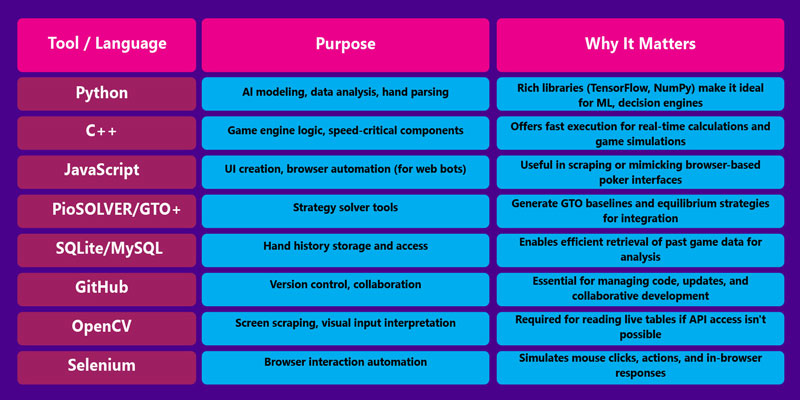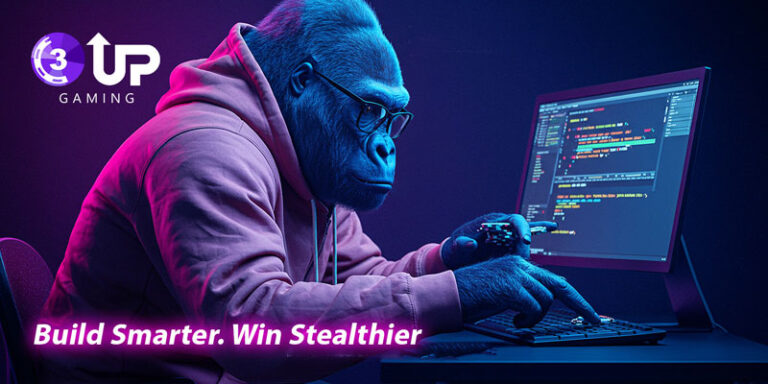Custom Poker Bot Development: Build Smarter, Undetectable AI Players! Custom-made pokerbots are sophisticated artificial intelligence that plays strong poker. Off-the-shelf versions of them are compared with custom versions that are made for a special opponent, a specific stakes level, or a specific way of playing.
Developers want to prosper on safer ground, but they want to go unnoticed at the same time. You may design a smarter, stealthy AI with the proper knowledge of strategy, coding, and anti-surveillance.
From design to ethics, this tutorial guides you through each aspect of custom poker bot development.
Custom Poker Bot Development: Build Smarter, Undetectable AI Players!
Unlock the full potential of AI with custom poker bot development tailored to your unique gaming needs. Our advanced solutions focus on building intelligent and undetectable AI players that mimic human behavior and make data-driven decisions in real time.
Whether you’re aiming to enhance your online poker platform or test strategies in a controlled environment, our bots are designed to stay under the radar while delivering top-tier performance. With seamless integration, adaptive learning capabilities, and a strong emphasis on stealth, our custom poker bots give you the competitive edge you need in today’s dynamic gaming landscape.
Why Develop a Custom Poker Bot?
Shelf pokerbots are inflexible or insensitive to human dynamic resistance. Currently available pokerbots have full control over strategy, anti-detection, and scalability. A completely application-specific, custom-built bot for academics, competitive usage, or research provides for:
- Accuracy: Tailor techniques to styles or formats of players.
- Control: Change the behavior free from vendor constraints
- Innovation: Incorporate new models such as reinforcement learning or simulation bluff.
- Evasion: Implement sophisticated anti-detection layers.
Professional developers who want to take over or even try to get into cracking of AI poker business, bespoke solutions provide opportunities no out-of-the-box bot ever can.
Essential Programming Languages and Tools (table)
Here’s a comprehensive table for this section:

Creating a Strategy Blueprint
There has to be a clear plan set forth before any piece of code is ever written. This document dictates the bot’s action during the pre-flop, flop, turn, and river stages of a hand as well as its bluff rate, risk tolerance, and reaction to various kinds of opponents.
The plan is a playbook, prescribing decisions on an intellectual trajectory rather than an arbitrary act basis.
A well-crafted strategic plan takes into account:
- Position and stack size-based range charts.
- Cash game, tournament, and sit-n-go game modes.
- Adjustment rules to weaker competition or unforeseen strategy.
- Backup strategies when data are thin or ambiguous.
Beyond dynamic variables such as bluffs per hour and bet size for live play, the static elements of the blueprint are ranges to open. The exploitative and the GTO machine are then controlled by this plan, allowing the bot to make decisions by situation.
Implementing Game Theory Optimization (GTO)
GTO is the mathematics that renders a poker strategy unexploitable. It stops the bot from being exploitable each second via bluffs, value bets, and folds. Playing GTO is obtaining the correct method of presenting diverse options, something that is possible with some software or by the bot learning itself.
Main points:
- Range balancing is the process of randomizing our strong and weak hands in order to be balanced and unpredictable.
- Solver results can tell you that you can use a tool like PioSOLVER, Simple Postflop, or GTORB to construct decision trees in advance.
- Live GTO adjustments are a conservative approach to tweaking the logic of the solver. It enables the bot to implement adjustments to its strategy during the game while playing live.
- Exploit resistance is when a GTO-based bot defends against overadjustment against opponents and has a stable long-term expected value.
GTO establishes a solid groundwork, and exploitative layers provide excellent information allowing one to capitalize on player mistakes; an appreciated trait to diligent individual development.
Building a Hand History Analyzer

To take from earlier games and adjust your bot’s strategic play, you’ll need the services of a Hand History Analyzer. Patterns of play, tendencies, and tendencies against exploitative and adaptive modules are examined in the play history.
Parsing engines, pattern matching, database storage, and visualisation dashboards constitute the solution. Parsing engines crawl raw hand data, pattern matching extracts opponent-specific leaks, database storage warehouses hands for bulk query and batch process, and visualisation dashboards chart win/loss patterns, bet frequency, and winning percentages.
Hand history analysis, your bot isn’t theory anymore, drawing conclusions from statistically significant, opponent-specific facts.
Integrating Real-Time Decision Engines
If a certain poker bot is to be dynamic and interactive, it must be programmed to make a decision in real time. It’s by observing the current state of the game and making decisions based on the best move in an infinitely small fraction, that these computers try to mimic the momentary strategic thinking of grandmaster human players and then simply appear for you, whenever you wish.
The system base bricks are strategy modules into pre-trained neural networks or solver-based models. Action executors, output to timed randomized input, delay control, which provides response time to lower complexity at expense, and game state readers, reading live data from the interface or memory at interval, are also part of it.
A well-rolled-out decision engine makes your bot an active player and not a passive program that can respond to tempo changes, table play, and wild cards.
Anti-Detection Techniques and VPN Integration (table)
We could simplify this sections into the following table:

They’re intended to avoid behavioral and system-level bot detection, keeping your AI player hidden in the weeds. The goal is not perfection, but rather enough obscurity to fly under the radar among the crowd.
Testing in Sandbox Environments
Before being released into the world, your robots must undergo lengthy testing in safe, regulated environments. They must pass some tests. I refer to them here.
Offline simulation is the process of executing hundreds of simulations on previously acquired simulated data sets or hand histories. You will need a closed-loop test and use OpenHoldem or PokerStove, along with private poker servers, to simulate betting logic and interaction.
You will need a behavior monitoring tool to watch your bot’s response, bet size, and timing in various situations. In addition, a test in debug mode will have logging hooks to track decisions and problems, so that strategic logic can be adjusted.
Sandbox testing makes certain that your bot behaves as intended prior to subjecting it to actual stakes or risking getting caught.
Scaling from Heads-Up to Full Table
Heads-up play is easier: fewer players, less variance, smaller action space. Scaling to multiplayer tables requires having to take some follow-on steps that are crucial to your design.
More preflop/postflop ranges, opponent model layers to monitor player types and frequencies, multiple threads for each opponent state and history of actions, and position sensitivity to account for early/late position effects on hand choice and aggression are all necessary for your bot to scale to multiplayer tables.
Complexity to scale increases exponentially but is needed in competitive environments.
Read More: Top White Label Poker Development Company: How to Choose the Best Partner!
Legal and Ethical Implications
Poker bot use is fraught with jurisdictional and legal problems, and most sites discourage it. Bot use in certain locations is against cybercrime or gaming statutes, risking their exposure or imposing legal penalties upon them which endanger the user. You need to be aware of this because it could prevent you from draining into lengthy and expensive avenues.
Unfairness controversy surrounds the reality that bots can alter the playing field, particularly if they are hidden. Creating bots for testing or research to evaluate AI is a different matter than putting them into games played for money.
Transparency, discretion, and intent matter, said all in a hurry to stake out the moral ground. Lines of morality are crossed quickly when bots compete against human players unaware of the unevenness.
Deployment, Maintenance, and Updates
Custom Poker Bot Development matters. All such as Deployment, Maintenance, Data Refresh, Adaptability, or Detection Avoidance are hindering us, for which explanation is needed. We will learn it in our concluding section step by step.
You’ve got to deploy to test environments first. Employ headless mode with API calls for real-time deployment. You’ll need frequent update strategy parameters too, patch bugs, and to keep up with platform changes. When we talk about data refresh, you have to enter new hand histories and meta trends so as to avoid stagnation or repetition of patterns. By way of adaptability the use of self-play or RL loops in order to keep strategies dynamic, especially in multi-opponent areas is at work. And your rotate VPNs, must demonstrate changing behavior timing, and audit logs to determine platform countermeasures.
Maintaining a bot alive is not a one-off job. It’s a constant warcraft between optimization and obfuscation.
FAQs: Custom Poker Bot Development
1. Is it legal to use a poker bot on online platforms?
No, by and large, platforms clearly forbid bots; employing them violates conditions and may result in bans or lawsuits.
2. What makes a poker bot ‘custom?
A custom bot includes special strategy logic, decisional rules, and, in many cases, distinctive detection avoidance techniques.
3. How long does it take to develop a working poker bot?
Depending on the complexity, functionalities, and testing iterations, the timeframe can range from several weeks to many months.
4. Can a poker bot win consistently?
Yes, particularly in more predictable or low-stakes markets. However, unpredictability, detection, and the construction of metagames can all have long-term impact on ROI.
5. What are the risks of using poker bots?
Platform bans, legal ramifications, and moral damage to the game’s integrity are all extreme risks. Undetected bots threaten to grind strategy to a standstill unless regularly updated.

